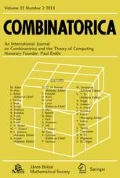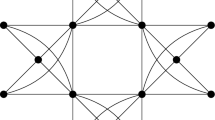We study random subgraphs of the n-cube {0,1}n, where nearest-neighbor edges are occupied with probability p. Let p c (n) be the value of p for which the expected size of the component containing a fixed vertex attains the value λ2n/3, where λ is a small positive constant. Let ε=n(p−p c (n)). In two previous papers, we showed that the largest component inside a scaling window given by |ε|=Θ(2−n/3) is of size Θ(22n/3), below this scaling window it is at most 2(log 2)nε−2, and above this scaling window it is at most O(ε2n). In this paper, we prove that for \( p - p_{c} {\left( n \right)} \geqslant e^{{cn^{{1/3}} }} \) the size of the largest component is at least Θ(ε2n), which is of the same order as the upper bound. The proof is based on a method that has come to be known as “sprinkling,” and relies heavily on the specific geometry of the n-cube.
Similar content being viewed by others
Author information
Authors and Affiliations
Corresponding author
Rights and permissions
About this article
Cite this article
Borgs, C., Chayes, J.T., van der Hofstad, R. et al. Random Subgraphs Of Finite Graphs: III. The Phase Transition For The n-Cube. Combinatorica 26, 395–410 (2006). https://doi.org/10.1007/s00493-006-0022-1
Received:
Issue Date:
DOI: https://doi.org/10.1007/s00493-006-0022-1




